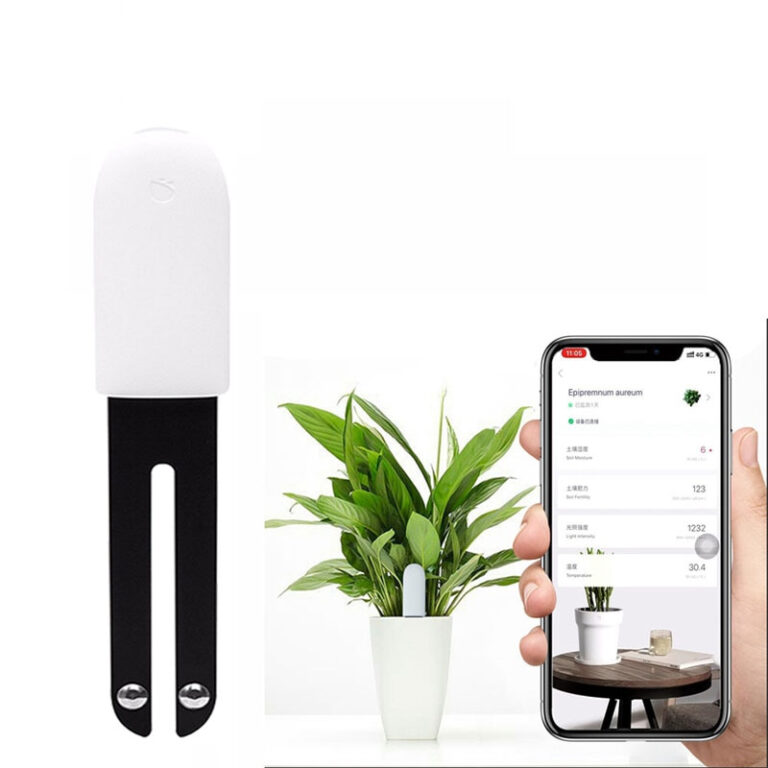What is a soil moisture meter?
One Humidity meter til jord og planter, kan aflæse og fortælle dig præcis, hvordan dine planter har det, og hvad de har brug for. Har dine planter brug for mere eller mindre vand, lys eller måske gødning?
A meter is a simple and effective tool for both your indoor and outdoor plants, allowing you to give your plants the best care and growing conditions. It can be particularly useful for plants like orchids that have specific watering needs.
How do I use the meter?
It is very simple to use the measuring instrument. The meter's spear is placed approx. 10-15 cm into the soil of the plant you want to measure. Your data can be read after a few minutes.
-
Insert the probe: Stik den forsigtigt ned i jorden tæt på plantens rødder. Sørg for, at den kommer mindst 10-15 cm ned, afhængigt af plantens størrelse og pottejordens dybde.
-
Read the meter: Wait a moment and read the meter. Some show the result on a scale where "dry", "damp" and "wet" are marked, while other models use numbers to indicate the moisture level.
-
Assess the need: If the meter shows the soil is dry, water the plant. If it says the soil is moist or wet, wait to water. This will help avoid overwatering.
-
Clean the probe: Remember to wipe the probe dry after use to prevent soil and residue from affecting future measurements.
This method ensures that you only water when necessary, which can improve plant health and growth.
Depending on which model you have chosen, you will now receive information about the plant's humidity, light conditions, fertiliser, temperature and ph value. Read the package insert in your specific meter and follow the instructions on your chosen product.
Types of moisture meters:
There are different types of moisture meters: A digital and a so-called smart moisture meter would be ones we recommend.
Digital soil meter
En digital jordmåler er som navnet antyder digitalt, hvilket giver adgang til mere præcise målinger. Det betyder dog også, at måleren bruger batteri.
When using a digital moisture meter, you can access multiple measurements by placing the spear in the ground and taking a reading.
With us you can find someone who can analyze and measure up to five different things at a time:
- Brightness
- Air temperature
- Soil moisture content
- Earth's temperature
- Ph value
In this way, you can easily test the plant's environment. The digital version is suitable for those who want a thorough analysis of your plants with a simple and easy-to-read measuring instrument, as the screen is large and bright with background lighting.
We recommend Digital Soil Tester, which you can buy from us and find in our range here.
Smart soil and moisture meter
En smart fugtighedsmåler er den nyeste version af målere, som til forskel fra den digitale, kan tilkobles din smartphone eller tablet, hvilket gør det nemt at overvåge dine planter hvor og hvornår du ønsker det.
Through an affiliate APP, you can keep an eye on the light intensity on the plant, temperature, humidity and available nutrients in the plant's soil both indoors and outdoors in real time. In other words, this gives you a very precise overview of the plant's condition, which makes it easy to adapt the conditions so that the plant thrives as best as possible.
The app also has a database of over 5000 plants and flowers' optimal conditions, giving you far more information than other types of meters. On the app, it is possible to tell the plant sensor which specific type of plant it should take measurements on.
As all plants are different with different needs, this ensures that the individual plant is taken into account and gives you the best analysis and the best recommendations.
You will find a wide range of tips for caring for and maintaining your plants. All in all, a really good solution for you who want a quick and very precise overview of the condition and needs of your various plants, which can be connected to your smartphone.
We recommend that you get one måler til jord og planter m. Bluetooth og app. You can read more and buy a smart moisture meter in our range here.
Why use a digital humidity meter and why it's best.
Using a digital moisture meter for plants and soil is a useful tool to ensure your plants have a good and healthy life.
-
Precise measurement: En digital måler giver præcise og hurtige aflæsninger. Så det lettere for dig at vurdere, om jorden er for tør eller for våd, hvilket hjælper med at undgå overvanding eller udtørring af planten.
-
Easy unloading: Den digitale målere viser klare tal eller tegn som er nemme at forstå. Dette minimerer risikoen for fejltolkning af fugtniveauet.
-
Extra features: Humidity meters also offer functions such as temperature measurement, light measurement or pH levelwhich gives you an understanding of the plant's environment and needs.
-
Ease of use: A digital meter requires no experience to use and provides instant feedback.
In summary, a digital moisture meter is best because it provides accurate and fast readings, is easy to use, and often comes with extra features that can improve your plant care.
Here's an overview of two types of moisture meters and their pros and cons to help you find the meter that best suits you and your plants.
|
Types of moisture meter |
Advantage |
Disadvantages |
|
· More precise measurements · Has multiple functions · Easy to read on screen |
· Uses battery · Cannot be connected to smartphone |
|
|
· Many different functions · Thorough analysis and specific recommendations · Associated app with large database about plants · Can monitor plants when you want it · Records and saves measurements for later analysis · Real-time monitoring on smartphone |
· Uses battery |
Analogue soil moisture meter vs. Digital soil moisture meter.
The analogue and Digital Moisture Meter do the same thing, measuring the moisture in the soil, but the difference lies in reading, accuracy and functionality.
1. unloading:
Analogue: If you need to read manually, it has a needle that moves along a scale (e.g. "dry", "moist", "wet"). It requires no batteries, the reading may be imprecise or harder to interpret, but is simple to use,
Digital: Displays an accurate number or is often easier to understand, many digital models make it simpler to measure accurately as they also show the humidity percentage directly.
2. precision:
Analogue: Has readings that may be less accurate and dependent on the sensitivity of the scale.
Digital: Provides more accurate measurements and can be better for small adjustments in humidity levels.
3. Features:
Analogue: Typically has only one function - to measure soil moisture.
Digital: Can come with more features and versatility, it can measure temperature, pH level and light intensity, making it useful for plant care.
4. Power supply:
Analogue: Requires no power or batteries.
Digital: Requires batteries to operate.
Digital soil moisture meter vs. smart soil moisture meter.
A digital soil moisture meter and a smart soil moisture meter can both measure soil moisture, but the difference lies in their readings, features and ease of use:
1. reading and data:
Digital: Here you need to check directly on a screen and read the humidity level on the device.
Smart: You can connect this via an app to your smartphone and have the soil readings sent to you. It can send notifications about when to water and save data.
2. Features:
Digital: Provides precise measurements of humidity, and other times functions like pH or temperature measurement.
Smart: Provides detailed analysis of soil and plant needs. Features wireless connectivity with smart home systems and the ability to monitor humidity remotely.
3. Ease of use:
Digital: Requires you to be at home so you can manually check the moisture level by looking directly at the meter.
Smart: This is monitored via an app so you can easily keep track of your plants' needs even when you're not at home.
4. Data collection and analysis:
Digital: Only shows here and now data and you have no option to save measurements.
Smart: You can save and analyse data over time so you can adjust plant care based on data.
A smart soil moisture meter is more advanced and allows for away-from-home monitoring, data storage and more detailed analyses of soil conditions, while a digital soil moisture meter is simpler and provides direct readings without advanced features.
Summary
As you can read here, is one moisture meter for soil an effective tool for you who want to give your plants the best possible growth conditions.
It can be used for both your indoor plants and outdoor plants, and you can use the measurements to give the plant what it needs based on the meter's analysis and recommendations.
The meter is easy to use and you can find exactly the model that's right for you. From the digital to the more advanced and thorough smart meter. You can get a quick overview of the pros and cons of the two models in the table above. You can find the two models on this page. Have fun with your humidity meter!
Take a look at ours grow lights for plants, if you or your moisture meter tells you that your plant is getting too little light. You can read more and find grow lights for plants here.
Remember that we are always ready to help you with advice and guidance in light and measuring instruments for plants
- Contact us here.
FAQ - Frequently Asked Questions
How moist should the soil be
The soil should be moist but not soaked, depending on the needs of the plant. For orchids, the soil should be kept slightly moist, but to avoid root damage don't stay wet, let the soil dry out a little between waterings. For common houseplants, the soil should be evenly moist, but overwatering can damage the roots. Plants like cacti need the soil to dry out almost completely between waterings. This is where a moisture meter can be useful to ensure the right moisture level for different plants.
Can you measure soil moisture
As it's easy to overwater or underwater your plants, it's good to measure soil moisture. The most accurate and practical method is to use a moisture meter, which has a probe that is inserted into the soil to measure the moisture content.
Can you use a moisture meter for outdoor plants
You can use your moisture meter for outdoor plants. During dry periods or when growing plants that require precise watering, a humidity meter is good to have.
can plants get too much water
Too much water can be harmful to them. Overwatering can cause the soil to become too wet, which prevents oxygen from reaching the plant's roots, and when they don't get enough oxygen, the roots can drown and start to rot. This weakens the plant and can lead to disease or, in the worst case, kill it.
What does a humidity meter cost
The price of a humidity meter varies depending on model, features and quality.
Simple analogue humidity meters: Displays humidity on a simple scale with no extra features. These models cost between 50-150 DKK.
Digital humidity meter: Depending on their digital features, the price for these ranges between 100-300 DKK.
Smart humidity metersAdvanced models that you connect to apps and provide more detailed data on the state of the earth. Depending on the brand and features, they typically cost between 250-800 DKK or more.
How does a humidity meter work
To measure soil moisture levels, a moisture meter is inserted into the soil to show how much water is in it. The reading shows whether the soil is dry, moist or wet and this method helps you to know when the plant needs watering



_large.png)



